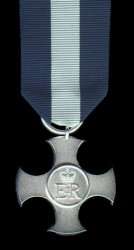Distinguished Service Cross (United Kingdom)
| Distinguished Service Cross | |
|---|---|
|
The medal. Ribbon: 36mm, three equal parts of dark blue, white, and dark blue. | |
| Awarded by United Kingdom of Great Britain and Northern Ireland | |
| Type | Military decoration. |
| Eligibility | British, (formerly) Commonwealth, and allied forces. |
| Awarded for | ... gallantry during active operations against the enemy.[1] |
| Status | Currently awarded. |
| Description | 43mm max height and width; plain silver cross with rounded ends. (Obverse) Royal Cypher in centre, surrounded by a ring; (reverse) plain. |
| Statistics | |
| Established | 15 June 1901 (as Conspicuous Service Cross), renamed October 1914. |
| Total awarded | During World War I: 1,983. Since 1945: fewer than 100. |
| Order of Wear | |
| Next (higher) | Royal Red Cross, First Class[2] |
| Next (lower) | Military Cross[2] |
| Related | Distinguished Service Medal |
The Distinguished Service Cross (DSC) is a third level military decoration awarded to officers, and (since 1993) other ranks, of the British Armed Forces, Royal Fleet Auxiliary and British Merchant Navy and formerly also to officers of other Commonwealth countries.
The DSC, which may be awarded posthumously, is granted in recognition of "... gallantry during active operations against the enemy at sea."[3]
History
The award was originally created in 1901 as the Conspicuous Service Cross, for award to warrant and junior officers ineligible for the DSO. It was renamed the Distinguished Service Cross in October 1914, eligibility being extended to all naval officers (commissioned and warrant) below the rank of Lieutenant Commander. In 1931, the award was made available to members of the Merchant Navy and in 1940 eligibility was further extended to non-naval personnel (British Army and Royal Air Force) serving aboard a British vessel. Since the 1993 review of the honours system, as part of the drive to remove distinctions of rank in awards for bravery, the Distinguished Service Medal, formerly the third level decoration for ratings, has been discontinued. The DSC now serves as the third level award for gallantry at sea for all ranks.
Since 1916, bars to the DSC have been awarded in recognition of the performance of further acts of gallantry meriting the award. Recipients are entitled to the post-nominal "DSC".
Description
- This DSC is a plain silver cross with rounded edges. The obverse has a circular centre within which can be seen the Royal Cypher of the reigning monarch at the time of award. From 1940 year of issue has been engraved on lower limb of cross.
- The reverse is plain apart from the hallmark and the ribbon is attached via a hall-marked silver ring.
- The ribbon has three equal stripes of dark blue, white and dark blue.
| Ribbon bars of the Distinguished Service Cross | |||||
|---|---|---|---|---|---|
DSC |
DSC and Bar |
DSC and Two Bars | |||
Four-time recipient
Only one person has ever been awarded the Distinguished Service Cross four times. Norman Eyre Morley served in the Royal Naval Reserve during World War I and World War II. He was awarded the DSC for the first time in 1919. He was awarded his second DSC in 1944. He was awarded the DSC a further two times in 1945. He gained an entry into the Guinness Book of Records as the most decorated reserve officer.[4][5]
List of three time recipients
- Sir Robert Atkinson, served in the Royal Navy during World War II
- Patrick Bayly, served in the Royal Navy and rose to the rank of vice admiral
- George Onslow Graham, served in the Royal Navy and the Royal New Zealand Navy[6]
- Robert Peverell Hichens, served in the Royal Navy during World War II and later recommended unsuccessfully for the Victoria Cross
- Geoffrey John Kirkby, served in the Royal Navy during World War II. Awarded DSC in 1940, 1942, and 1944.
- Charles Lightoller (highest surviving officer on RMS Titanic), served in the Royal Navy during World War I, volunteer in World War II. Awarded DSC in 1916, 1918.
- Thomas Le Mesurier, served in the Royal Air Force during World War I as a flying ace credited with seven aerial victories. Awarded DSC twice in 1917 and in 1918.
- George James Macdonald, served in the Royal New Zealand Navy
- Richard Minifie, served in the Royal Naval Air Service during World War I. Awarded DSC in twice in 1917 and in 1918.
- Stanley Orr, served in the Royal Navy during World War II. Awarded DSC in 1940, 1941, and 1944.
- Peter Piper, served in the Royal Naval Reserve during World War II. Awarded DSC in 1939 and twice in 1941.
- Jack Scatchard, served in the Royal Navy during World War II and the Cold War
- Skule Storheill, served in the Royal Norwegian Navy and attached to the Royal Navy during World War II
- Bob Whinney, served in the Royal Navy during World War II. Awarded DSC thrice in 1944.
See also
- Recipients of the Distinguished Service Cross
- British and Commonwealth orders and decorations
Notes
- ↑ Defence FactSheet Accessed 28 June 2007.
- 1 2 "JSP 761 Honours and Awards in the Armed Forces" (PDF). p. 12A-1. Retrieved 7 November 2014.
- ↑ The London Gazette: (Supplement) no. 56693. p. 11146. 17 October 2002. Retrieved 30 April 2009.
- ↑ The London Gazette: (Supplement) no. 37127. p. 3088. 8 June 1945. Retrieved 24 April 2015.
- ↑ "Lot 350: An Important Collection of Royal Navy Items Relating To Commander Norman Morley DSC". Bonhams. 2007. Retrieved 24 April 2015.
- ↑ The London Gazette: (Supplement) no. 39854. p. 2765. 15 May 1953. Retrieved 24 April 2015.
References
- Mackay, J. and Mussel, J. (eds). Medals Yearbook – 2005, 2004, Token Publishing.
